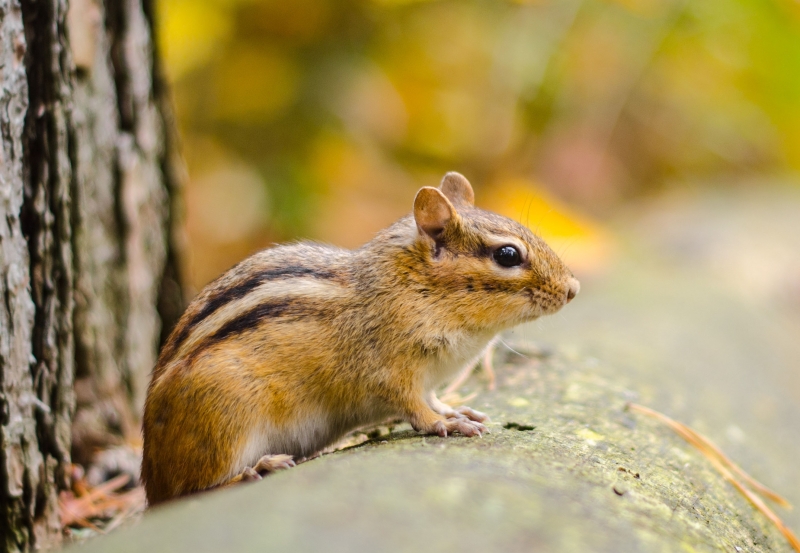
Lyme Disease Ecology Part Two: Is Biodiversity a Buffer?
You might be wondering – what does ecology have to do with my risk for catching Lyme disease, anyway? In our first post about Lyme disease, we introduced the blacklegged tick (also commonly called deer tick), the creepy crawly arachnid that transmits pathogens to unwitting hikers, hunters, and gardeners. As much as we’d like to blame ticks, and ticks alone, for getting us sick, it turns out they need help from other species before they pass the disease on to humans.
Lyme disease is a zoonosis– that is, a disease that can be passed on between animals and humans. Approximately 60% of known human diseases are zoonoses - others that have been in the limelight in recent years include West Nile Virus, dengue fever, and Ebola. In the case of Lyme disease, the bacteria (Borrelia burdorferi) is passed on to humans via ticks that have fed on another infected animal. For a human to contract Lyme disease, he or she must be bitten by a blacklegged tick that has previously fed on an infected animal host. Because of this, Lyme disease can be considered an ecological system which requires a minimum of four organisms: the Borrelia burdorferi bacterium, a blacklegged tick, a vertebrate host, and an unfortunate human.
 To review from the previous post, the blacklegged tick takes three meals in its lifetime, each corresponding to one of its three life stages: larva, nymph, and adult. Because each tick is born disease free, it must contract a pathogen from a host during one of its three meals in order to become dangerous to us. As it turns out, different species in a forest have vastly different likelihoods of harboring Borrelia and passing that infection along to ticks.
To review from the previous post, the blacklegged tick takes three meals in its lifetime, each corresponding to one of its three life stages: larva, nymph, and adult. Because each tick is born disease free, it must contract a pathogen from a host during one of its three meals in order to become dangerous to us. As it turns out, different species in a forest have vastly different likelihoods of harboring Borrelia and passing that infection along to ticks.
An animal is said to be a competent host for Lyme disease if it meets two key criteria: 1) it is ineffective at grooming ticks from its body; and 2) its immune system does not readily clear itself of new infections. Over the past two decades, researchers at the Cary Institute of Ecosystem Studies in Millbrook, NY, led by Richard Ostfeld, have studied the host competence of various Northeastern mammal and bird species to determine the most common wildlife reservoirs for Lyme disease (full disclosure: I worked at the Cary Institute as a research technician in the Ostfeld lab in 2009 and 2010). After live-trapping and testing as many species as possible, they came to a surprising conclusion: just four species - white-footed mice, short-tailed shrews, masked shrews, and eastern chipmunks – served as hosts for 90% of the Lyme-infected nymphal ticks at their study sites in the Hudson Valley. White footed mice (Peromyscus leucopus) were the worst offenders: they were not only the most abundant small mammals, but also the most likely to harbor Lyme disease.
While studies in the 1970s and 80s singled out white-tailed deer as the primary wildlife reservoirs of Lyme disease, it turns out their role was greatly exaggerated. Large mammals like white-tailed deer offer ample real estate for adult ticks to feed and breed, but because their immune systems are effective at clearing Borrelia burgdorferi infection, fewer than 5% of the ticks that bite them become infected with Lyme disease. So while deer do influence the abundance of ticks, their relative impact on the number of infected (i.e. dangerous) ticks is small. Over the past decade, Lyme disease has continued to emerge in new areas of the Northeast and Midwest, even as deer populations have remained stable.
 Other animals play important roles in determining the number of infectious ticks in a forest. Opossums are unlikely heroes in this story: these homely, rat-like marsupials are tick vacuum cleaners, capable of grooming and eating 4,000 ticks off themselves in a single week. Predators that eat small mammals, such as foxes and snakes, also help keep small rodent populations in check, limiting the abundance of the most common Lyme disease hosts. In areas where red fox populations are on the decline (likely due to growing populations of coyotes, which tend to displace foxes), Lyme disease rates are on the rise. Coyotes also eat small mammals, but they range over larger territories than foxes, thus lowering the overall density of predators in an ecosystem. Recent research has borne out that in fact, forests with greater density and diversity of small mammal predators (bobcats, raccoons, foxes, and opossums) had lower rates of Lyme infected nymphal ticks than forests home to coyotes alone.
Other animals play important roles in determining the number of infectious ticks in a forest. Opossums are unlikely heroes in this story: these homely, rat-like marsupials are tick vacuum cleaners, capable of grooming and eating 4,000 ticks off themselves in a single week. Predators that eat small mammals, such as foxes and snakes, also help keep small rodent populations in check, limiting the abundance of the most common Lyme disease hosts. In areas where red fox populations are on the decline (likely due to growing populations of coyotes, which tend to displace foxes), Lyme disease rates are on the rise. Coyotes also eat small mammals, but they range over larger territories than foxes, thus lowering the overall density of predators in an ecosystem. Recent research has borne out that in fact, forests with greater density and diversity of small mammal predators (bobcats, raccoons, foxes, and opossums) had lower rates of Lyme infected nymphal ticks than forests home to coyotes alone.
The upshot is this: the diversity of animals in your backyard, and in the woodsy areas where you work and play, has direct implications for your risk of contracting Lyme disease. Diverse wildlife communities not only reduce the risk that a tick will feed on an infectious host (this is called the dilution effect), but they also tend to contain more predator species that control the populations of the most common Lyme disease hosts. And when it comes to predicting the diversity of species within a given forest, size matters. Large tracts of forest tend to be home to larger and more varied communities of species. As we carve forests into fragments to make room for houses, farms, and developments, many of those species (bears, moose, songbirds, amphibians) become locally extinct. One group of species that seem to thrive, regardless of the size or quality of their habitat, is small rodents.
“We are losing species as we chop up the woods into littler and littler bits, but we’re not losing them randomly,” said Ostfeld in a recent lecture. “The three species that tend to survive end up being the white-footed mouse, the chipmunk, and the short-tailed shrew.” Unfortunately for us, these are the species most likely to pass Lyme disease along to ticks.
The work of Ostfeld and others has important conservation and human health implications. If decreasing forest size leads to decreased biodiversity, which leads to increased Lyme disease risk, then “The prediction would be that small forest fragments should be the riskiest places in the landscape. They should be places you avoid like the plague… or like the Lyme disease,” he remarked. In fact, multiple studies have shown that fragmented habitats, with lower host species diversity, have both higher rates of infected ticks, and more human Lyme disease cases.
What does this mean for us? Lyme disease prevention may be an ecosystem service that we gain from simply keeping wild lands wild. We might reduce our risk of contracting Lyme disease by conserving wildlife habitats so that there is plenty of room for species like hawks, weasels, foxes, opossums, owls and bobcats to thrive. We might also use extra caution when walking through forest edges, small woodlots, and degraded habitats during times of year when ticks are most active.
As Lyme disease continues to emerge in new regions of the St. Lawrence Valley and Adirondacks, many questions remain. Will the trends observed in the Hudson Valley hold true in the northern reaches of the state? How and why is Lyme disease spreading across our landscape? Which areas will become hot spots next? We’ll talk about North Country researchers who are tackling these questions, and what they are finding, in the next installment. But for now, take solace in knowing that maintaining healthy and diverse communities of our wild neighbors may go hand in hand with maintaining our own health.

